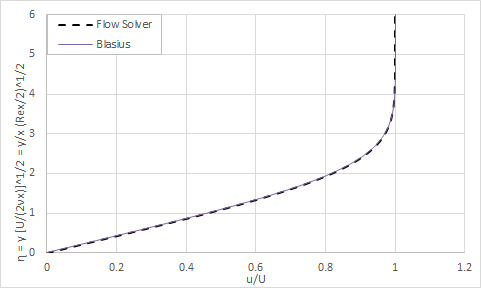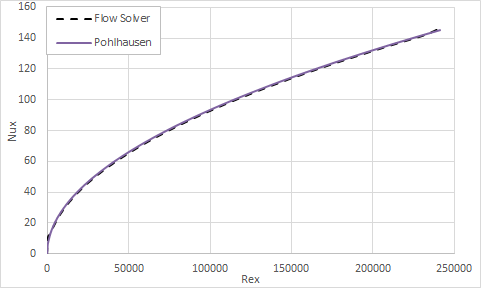VVC1 - Incompressible laminar flow over a flat plate
| Test case |
|---|
| SVTEST26 |
Description
This test case examines the incompressible laminar flow and heat transfer over a flat plate. The local friction factor, Nusselt number and velocity profiles are compared to the theoretical results of Blasius and Pohlhausen. The geometry and flow conditions are based on the related NPARC case [23].
Geometry
The geometry is a rectangular prism, 25.4 mm in height, 10 mm in width and 381 mm in length. The prism is partitioned along the length to give two sections, one of 76.2 mm and the other of 304.8 mm .
Simulation model
The swept mesh is made of hexahedral elements. The following mesh controls are used:
- Height: 50 elements, 0.94 bias
- Width: 2 elements
- Length, fore section: 30 elements, 0.9 bias
- Length, aft section: 100 elements, 0.97 bias
The fluid is modeled using incompressible air with the following properties:
- Mass density:ρ = 0.3706 kg/m3
- Thermal conductivity: k = 0.0263 W/m·C
- Dynamic viscosity: µ = 1.85e-005 Pa·s
- Specific heat at constant pressure: Cp = 1007 J/kg·K
The gas constant was kept blank in order to simulate a truly incompressible flow.
The following boundary conditions are applied:
- Flow Boundary Condition: Inlet Flow on the front of the prism with a velocity of 39.5 m/s and ambient external conditions.
- Flow Boundary Condition: Opening on the top and back of the prism.
- Flow Surface: Boundary Flow Surface on the bottom fore surface using the Slip Wall option.
- Flow Surface: Boundary Flow Surface on the bottom aft surface using the No Slip Wall option with smooth wall friction and automatic convection properties.
- Symmetry Plane on the right and left surfaces.
- Temperature constraint on the bottom aft surface with a value of T =126.9 °C.
The following solution options are set:
- Turbulence Model: None (Laminar Flow)
- Ambient Conditions: Ambient pressure = 41.4 kPa, ambient fluid temperature = 115.7 °C
- Initial Conditions: Lengthwise velocity = 39.5 m/s, pressure = 41.4 kPa, fluid temperature = 115.7 °C
The following solver parameters are selected:
- 3D Flow Solver: Time Step = 0.1 s
- 3D Flow Solver: Maximum Residuals = 1e-6
- 3D Flow Solver: Global Heat Imbalance Fraction = 1e-6
- 3D Flow Solver: Mass relaxation factor = 0.75
- 3D Flow Solver: Fluids relaxation factor = 0.9
- 3D Flow Solver: Momentum advection scheme = SOU with specify factor of 0.5
- Coupled Solver: Maximum Temperature Change = 1e-4 ∆°C
- Coupled Solver: Global Heat Imbalance Fraction = 1e-5
Theory
The theory of Blasius and Pohlhausen [8] is used as a basis of comparison for the solver results. In particular, we get for the friction coefficient and the Nusselt number:
where:
- Cf,x is the friction coefficient.
- τs,x is the shear stress.
- ρ is the air density.
- U is the free stream velocity.
- Rex is the Reynolds number.
- Nux is the Nusselt number.
- hx is the convection coefficient (based on the free stream temperature).
- x is the lengthwise position.
- k is the thermal conductivity of air.
- Pr is the Prandtl number of air.
Results
The friction coefficient results are contained in the following figure.

The velocity profiles at the plate end in function of the Blasius parameters are represented in the following figures.


The Nusselt number results are contained in the following figure.

The temperature profile at the plate end in function of the Blasius parameter is represented in the figure.

